When you think of paella, you might picture a vibrant dish brimming with saffron-infused rice and an assortment of seafood or meats. This iconic Spanish meal isn't just about the ingredients; it's steeped in history and cultural significance that traces back to Valencia in the 19th century. As you explore its origins and the various regional adaptations, you'll find that each version tells its own story. What might surprise you, however, is how its preparation methods and communal nature have evolved over time, reflecting broader changes in society.
Key Takeaways
- Paella originated in Valencia, Spain, evolving from a peasant dish to a celebrated symbol of Spanish cuisine, reflecting regional influences.
- Key ingredients include saffron, short-grain rice, seafood, vegetables, and a rich broth, essential for authentic flavor.
- Traditional cooking methods emphasize wood-fired techniques, minimal stirring for socarrat, and communal cooking experiences.
- Variations exist across Spain, including seafood, meat, and vegetarian options, each showcasing local ingredients and cooking styles.
- Modern adaptations incorporate vegan ingredients, fusion flavors, and international influences while maintaining the essence of traditional paella.
History of Paella
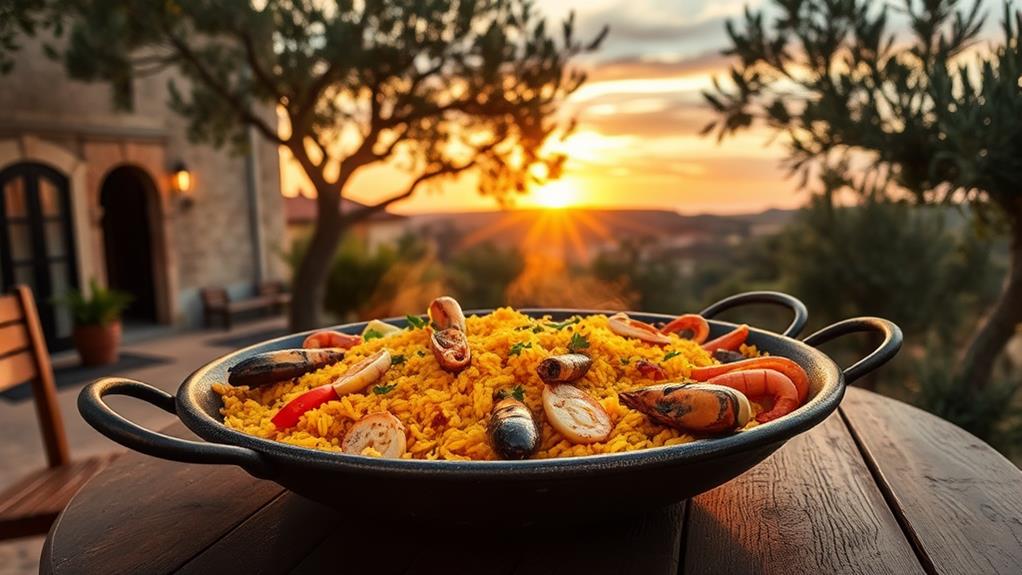
Paella has a rich history that dates back to the mid-19th century in Valencia, Spain, where it originated as a humble rice dish. Various origin theories suggest that its roots lie in the agricultural practices of the region, where farmers combined local ingredients with rice to create a hearty meal.
The dish reflects regional influences, showcasing the flavors and culinary traditions of Valencia, including seafood from the Mediterranean and vegetables from the fertile countryside.
As you explore paella's historical evolution, you'll notice how it transformed from a peasant dish to a celebrated national symbol of Spanish cuisine. Cooking techniques played a crucial role in this journey; the traditional wide, shallow pan, known as a "paellera," promotes even cooking and the coveted socarrat—the crispy bottom layer of rice.
Cultural exchanges have also shaped paella over time, with variations emerging as different regions and countries embraced the dish.
Whether you're savoring a seafood version or a meat-packed variant, each bite tells a story steeped in history, reflecting the diverse influences that have made paella a true culinary masterpiece.
Key Ingredients
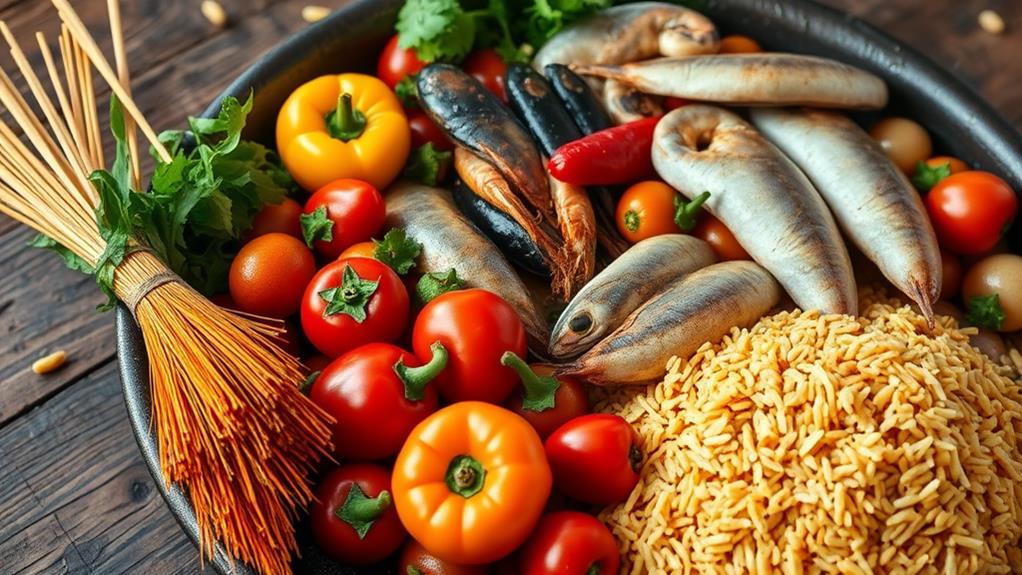
At the heart of every great paella lies a selection of key ingredients that bring the dish to life. The essence of paella comes from its vibrant flavors and textures, and understanding these components will elevate your cooking experience.
One of the most crucial ingredients is saffron, known for its golden hue and unique flavor. The saffron's importance can't be overstated; it infuses the rice with a rich, aromatic quality that defines authentic paella.
When it comes to rice varieties, the choice significantly impacts the dish's outcome. You should opt for short-grain rice, like Bomba or Calasparra, as they absorb the flavors beautifully without becoming mushy.
Here's a quick glance at key ingredients:
| Ingredient | Description | Importance |
|---|---|---|
| Saffron | A spice derived from crocus flowers | Adds flavor and color |
| Rice | Short-grain varieties like Bomba | Absorbs flavors and texture |
| Seafood | Fresh shrimp, mussels, or squid | Provides richness and depth |
| Vegetables | Bell peppers, peas, and tomatoes | Adds freshness and balance |
Traditional Cooking Methods

Often celebrated for its communal nature, traditional cooking methods for paella play a vital role in achieving the dish's authentic flavor and texture. One of the most cherished techniques is wood fired cooking, which imparts a distinct smoky aroma that enhances the overall experience.
When you gather around an open flame, the excitement builds as the ingredients meld together in a single pan. As you heat the pan, the saffron infusion comes to life. This precious spice, often referred to as the heart of paella, transforms the rice into a vibrant golden hue while imparting a unique flavor.
You'll want to let your rice absorb all the rich broth, allowing the saffron to work its magic. Stirring is minimal; you're aiming for that prized socarrat, the crispy layer of rice at the bottom.
As the dish cooks, the wood fire creates the perfect temperature, ensuring even cooking and that delightful caramelization. Embracing these traditional methods not only honors the history of paella but also deepens your connection to this iconic dish, making each bite a celebration of culture and community.
Variations Around Spain
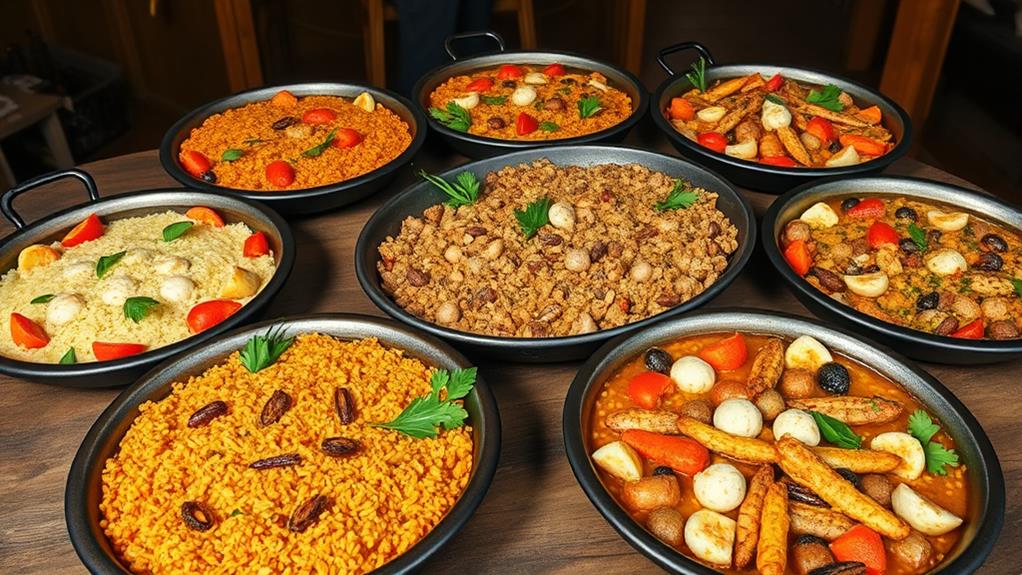
While traditional cooking methods lay the foundation for paella's rich flavors, regional variations across Spain showcase the dish's versatility and the unique culinary influences of each area.
In coastal regions, seafood variations like the famed "paella de mariscos" highlight the ocean's bounty, featuring fresh shrimp, mussels, and calamari. In contrast, inland areas might lean towards meatier options, incorporating rabbit or chicken, reflecting local farming practices.
Vegetarian options have also emerged, utilizing local vegetables combined with regional spices to create vibrant, flavorful dishes. You might discover ingredient substitutions tailored to seasonal availability, ensuring each version embodies the essence of its locale.
Cooking techniques vary, too; some regions favor slow-cooking methods, while others opt for quicker, high-heat approaches.
Serving traditions can differ greatly, from the communal sharing style at festival celebrations to the more formal plating seen in upscale restaurant styles. Each variation tells a story, inviting you to experience the diverse culinary landscape of Spain.
Whether you're sampling a seaside version or a rustic inland paella, you'll appreciate how these regional differences contribute to the dish's enduring popularity.
Tips for Perfect Paella
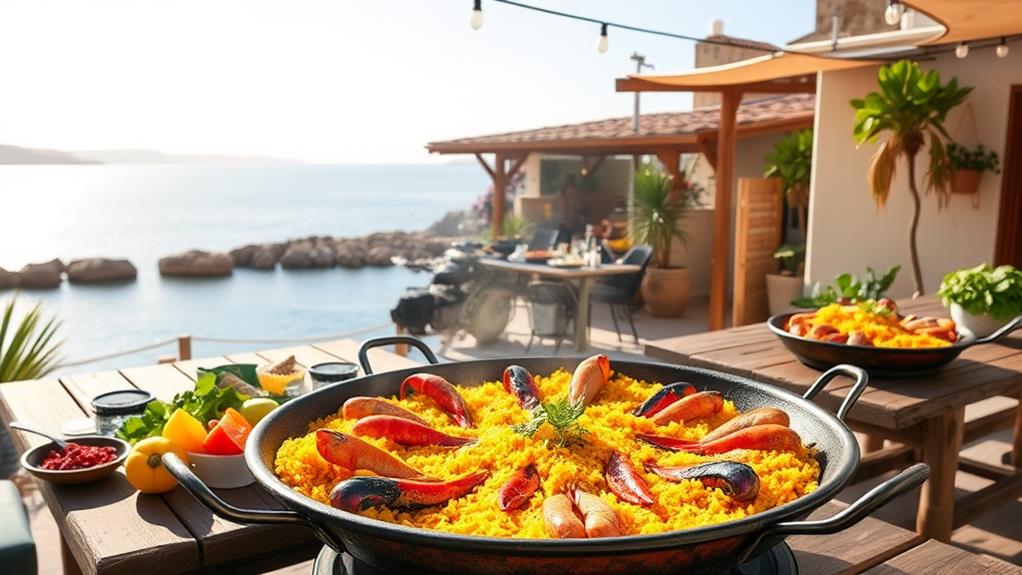
Achieving perfect paella requires a blend of technique and attention to detail, with five key tips that can elevate your dish from good to extraordinary.
First, focus on your saffron selection. Opt for high-quality threads rather than powder, as this enhances the flavor and color beautifully. Soak the strands in warm water before adding them to your dish for maximum impact.
Next, choose the right rice types. Short-grain rice, like Bomba or Calasparra, absorbs liquids better and creates that coveted creamy texture. Avoid long-grain varieties, as they won't deliver the same results.
Third, maintain a consistent heat while cooking. Start with high heat to develop a good socarrat—the crispy bottom layer—and then lower it to allow even cooking throughout.
Additionally, resist the urge to stir too much once the liquid is added; this helps form the socarrat.
Lastly, let your paella rest for about 5-10 minutes after cooking. This step allows the flavors to meld together beautifully.
Common Mistakes to Avoid
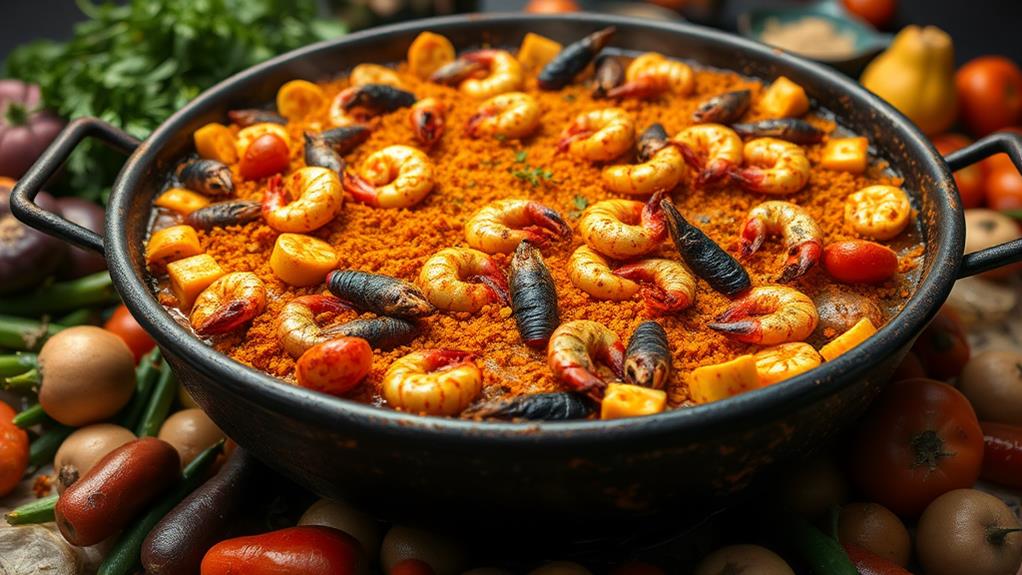
When making paella, a few common mistakes can derail your efforts and lead to a less-than-stellar dish. First, let's talk about cooking equipment. Using the wrong pan can significantly affect cooking time and texture. A wide, shallow pan allows for even cooking and helps achieve that coveted socarrat, or crispy bottom layer. If you're using a deep pot, you might end up with a soggy mess.
Next, ingredient sourcing is crucial. Don't skimp on quality! Fresh, authentic ingredients like saffron, bomba rice, and seasonal seafood make a world of difference. If you opt for substitutes or frozen options, you risk losing the dish's distinct flavor.
Also, be sure to avoid overcrowding the pan. When you add too many ingredients, they steam instead of sear, preventing that rich, complex flavor.
Lastly, resist the urge to stir. Once you've added the rice, let it cook undisturbed. Stirring breaks the rice and disrupts the cooking process, leading to uneven results.
Pairing With Beverages
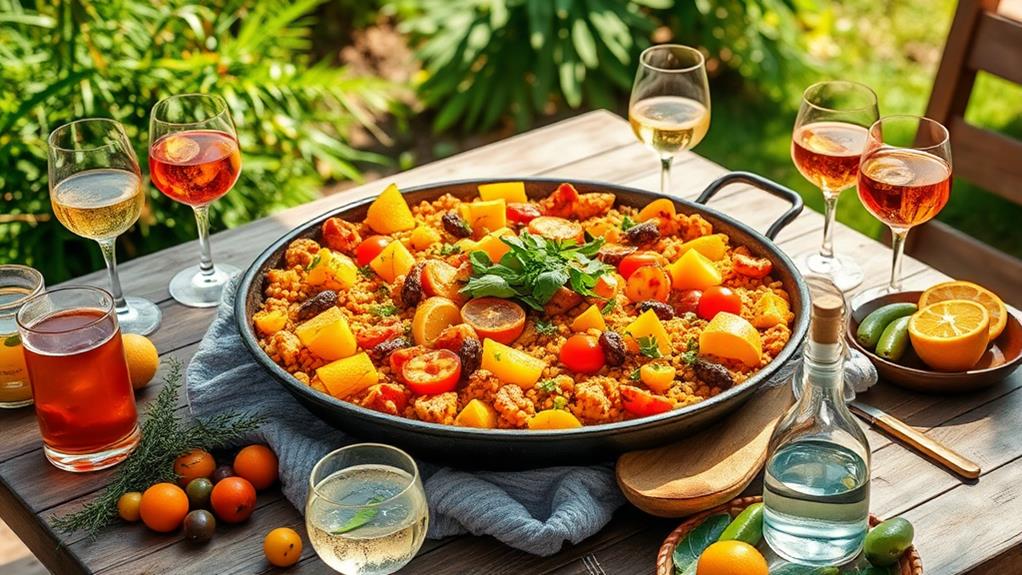
To elevate your paella experience, selecting the right beverages can truly enhance the dish's vibrant flavors.
When it comes to wine pairing, a crisp Albariño or a fruity Tempranillo complements the rich saffron and seafood beautifully, balancing the dish's flavors. If you prefer beer, consider a light, refreshing Spanish lager or a fruity pale ale; these choices won't overpower the paella's taste.
For cocktail options, a zesty gin and tonic infused with herbs can add a delightful twist.
Don't forget about non-alcoholic drinks—sparkling water with a splash of citrus or a fruity mocktail can also work wonders.
Regional beverages play a significant role in enhancing your meal. For instance, pairing your paella with a classic Sangria can add a festive touch, especially during summer months.
Seasonal pairings are essential, too; a warm fall paella may pair well with a spiced cider or a full-bodied red wine.
Cultural Significance
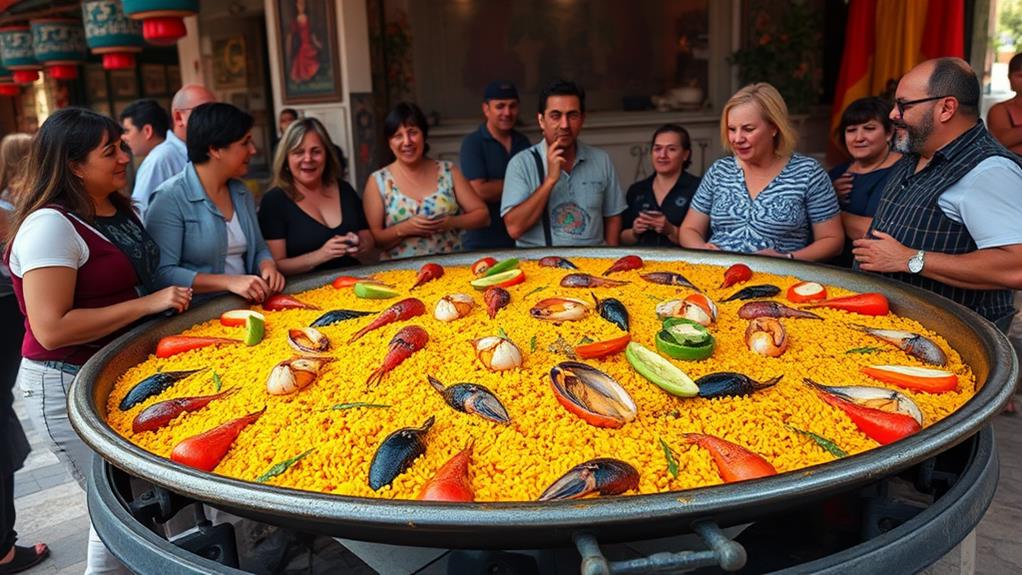
Paella isn't just a meal; it's a celebration of culture and community, deeply rooted in Spanish traditions. When you gather around a large, vibrant pan of paella, you're participating in a culinary experience that transcends mere sustenance. This dish embodies the essence of shared moments, often enjoyed during family gatherings, festivals, and special occasions.
The rich tapestry of paella reflects Spain's diverse culinary traditions. Each region contributes its unique flair, from the seafood-laden versions along the Mediterranean coast to the heartier, meat-based varieties found in the interior.
You'll notice these regional differences not only in the ingredients used but also in the cooking techniques passed down through generations. In Valencia, where paella originated, locals pride themselves on using specific types of rice and saffron, while in Andalusia, you might find a delightful mix of seafood and spices.
Paella in Popular Culture
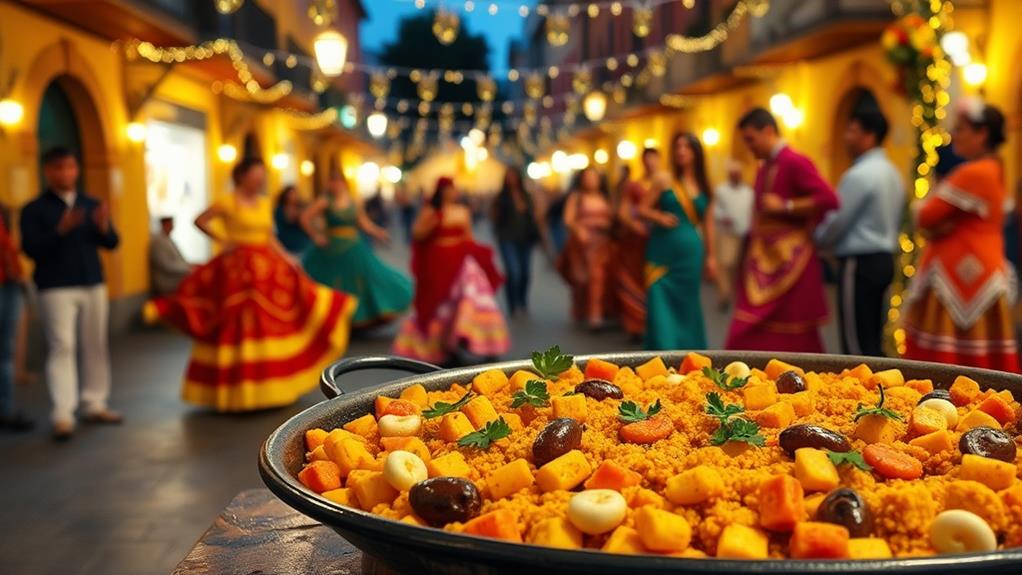
The vibrant colors and enticing aromas of paella have made it a star in the world of cuisine, appearing in films, television shows, and social media posts that celebrate culinary diversity.
You've likely seen paella references in popular media, where it's often portrayed as a dish of gatherings, love, and celebration. These portrayals encapsulate the dish's rich history and its ability to bring people together, making it a symbol of communal dining.
In movies, you might spot characters sharing a steaming paella at a festive gathering, emphasizing its role as a catalyst for connection and joy. Television chefs often showcase their versions, highlighting regional variations and inspiring you to create your own masterpiece at home.
Social media platforms are flooded with stunning images of paella, each post telling a story of tradition, creativity, and flavor.
Through these various expressions, paella symbolism transcends mere sustenance, representing culture, heritage, and the artistry of cooking.
As you explore this beloved dish in popular culture, you'll find it's more than just a meal; it's an experience that celebrates life and community.
Modern Takes on Paella
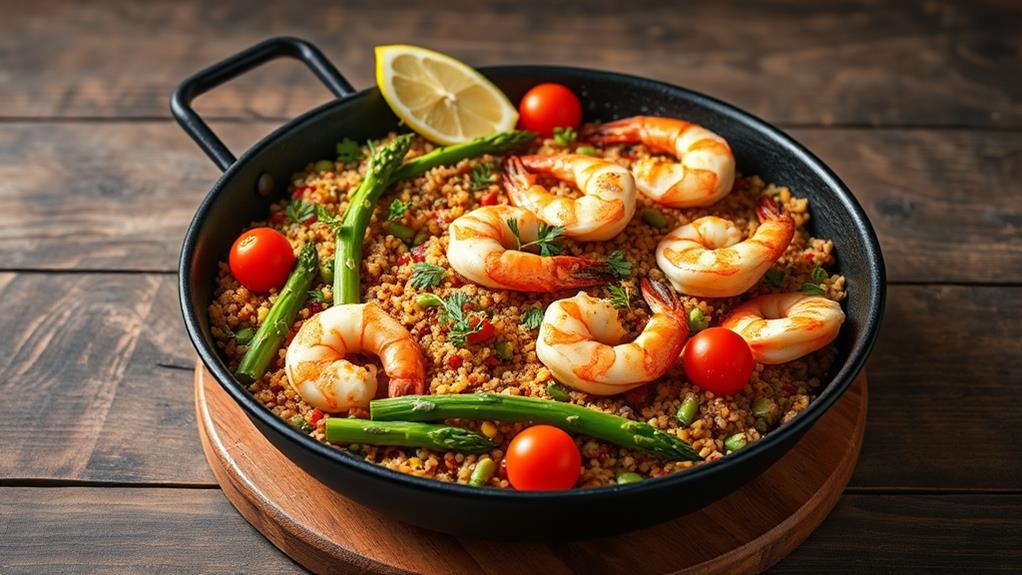
With its rich heritage and communal spirit celebrated in popular culture, paella has evolved into a canvas for culinary innovation. Today, you can experience a delightful array of modern takes on this classic dish.
Vegan paella, for instance, showcases seasonal ingredients like artichokes and bell peppers, appealing to the health-conscious crowd without sacrificing flavor.
You might also encounter seafood fusion variations, blending traditional saffron with exotic spices, creating a mouthwatering experience that tantalizes your taste buds. If you crave heat, spicy variations incorporate chili peppers or chorizo, giving a contemporary kick to this beloved dish.
International adaptations abound, as chefs from around the globe put their spin on paella. Think of Thai-inspired recipes featuring coconut milk or Indian versions with fragrant spices.
Gourmet twists elevate the dish, using premium ingredients like wild mushrooms or truffle oil, transforming a rustic meal into a fine dining experience.
No matter where your culinary journey takes you, the modern interpretations of paella reflect a vibrant tapestry of global influences, ensuring this iconic dish continues to inspire and satisfy.
Frequently Asked Questions
Can Paella Be Made in a Slow Cooker?
Yes, you can use slow cooker techniques to make delicious paella variations. Just layer your ingredients, adjust cooking times, and let the flavors meld beautifully. You'll enjoy a convenient, flavorful dish without the fuss!
What Side Dishes Pair Well With Paella?
When you're exploring side dishes, consider traditional accompaniments like crusty bread or a fresh salad. Regional variations might include roasted vegetables or seafood tapas, enhancing your meal with vibrant flavors and textures. Enjoy the experience!
How Do You Store Leftover Paella?
When you gather treasures, store them wisely. For leftover preservation, seal your paella in an airtight container. Refrigerate it for up to three days, then gently reheat, reviving flavors like a sunset over the sea.
Is Paella Gluten-Free?
If you're wondering about gluten-free options, many rice varieties used in dishes are naturally gluten-free. Just watch out for gluten sources like certain seasonings or processed ingredients that may sneak into your meal. Enjoy your dish worry-free!
How Long Does Paella Take to Cook?
Cooking time varies based on your techniques and ingredient variations. Typically, you'll need about 30 to 45 minutes. Adjusting heat and layering flavors can enhance the dish, making every minute count toward a delightful meal.
